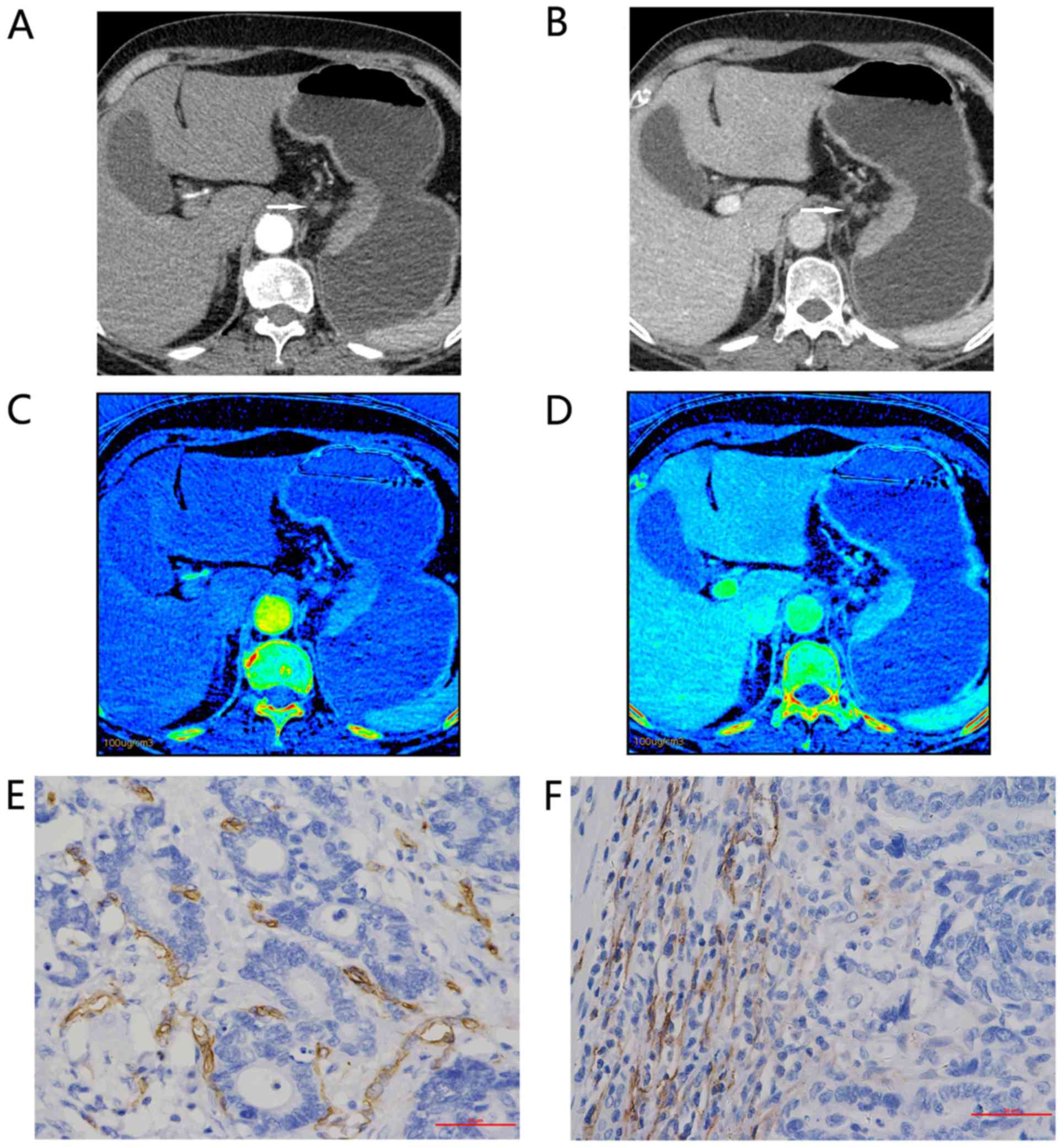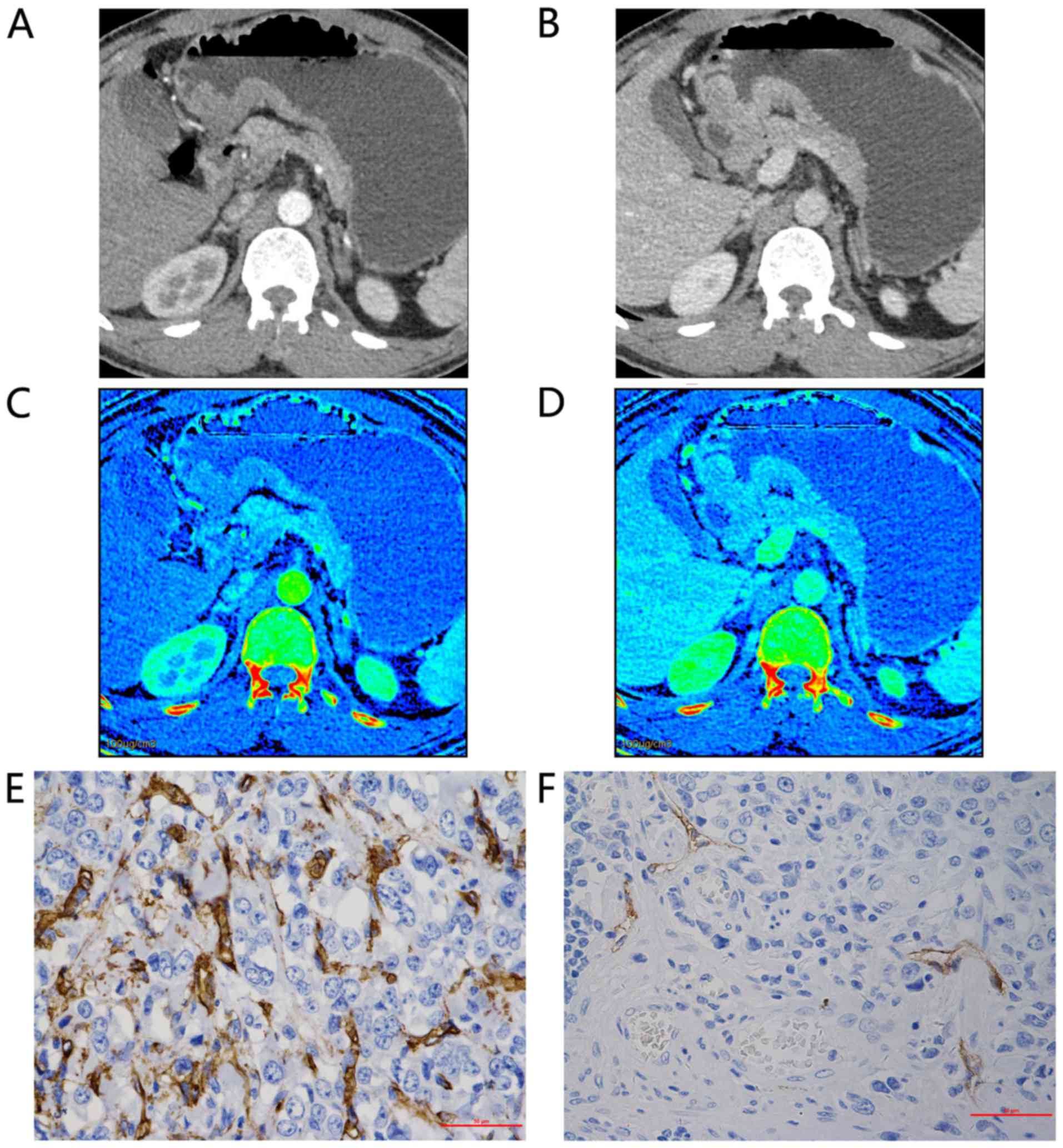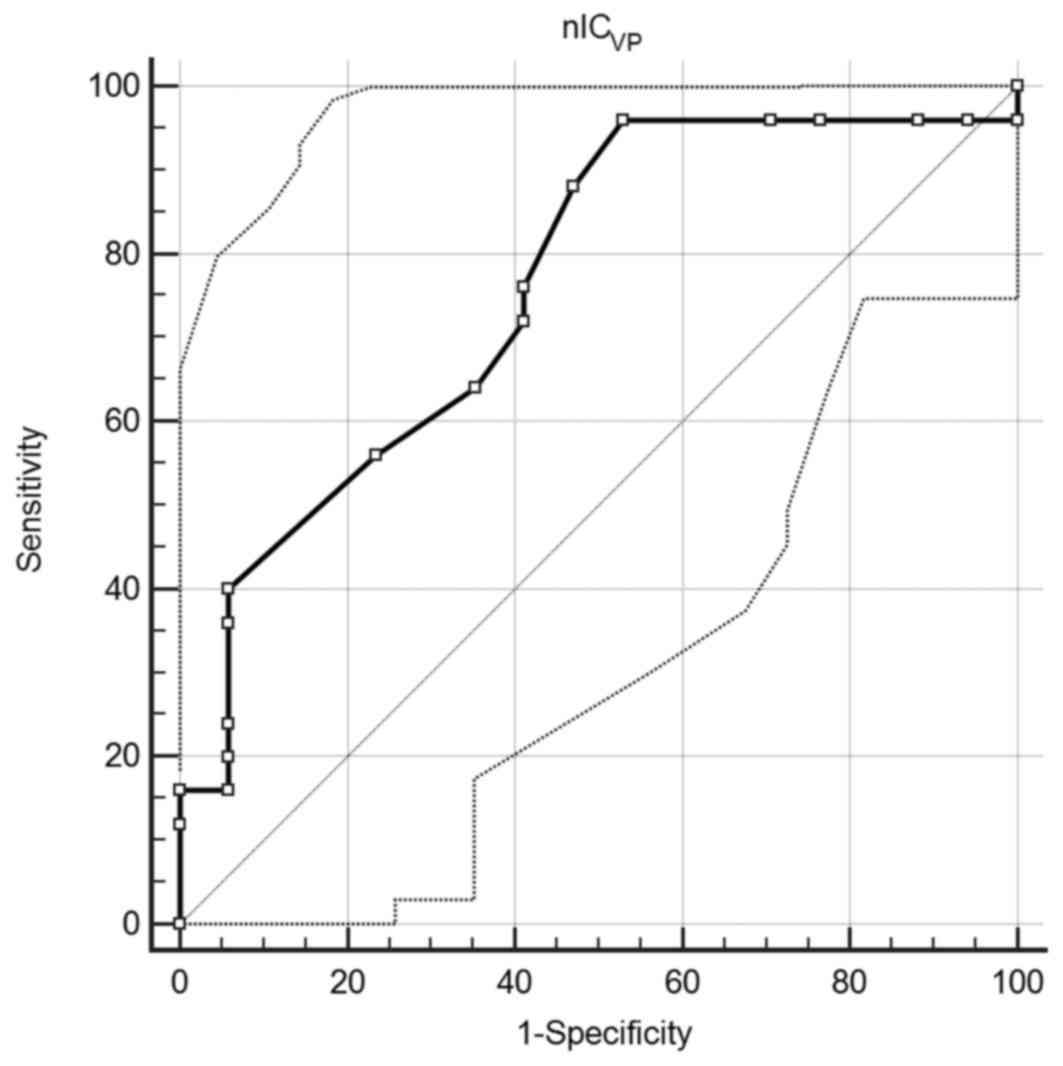|
1
|
Torre LA, Bray F, Siegel RL, Ferlay J,
Lortet-Tieulent J and Jemal A: Global cancer statistics, 2012. CA
Cancer J Clin. 65:87–108. 2015. View Article : Google Scholar : PubMed/NCBI
|
|
2
|
Robb WB and Mariette C: Predicting the
response to chemotherapy in gastric adenocarcinoma: Who benefits
from neoadjuvant chemotherapy? Recent Results Cancer Res.
196:241–268. 2012. View Article : Google Scholar : PubMed/NCBI
|
|
3
|
Saka M, Morita S, Fukagawa T and Katai H:
Present and future status of gastric cancer surgery. Jpn J Clin
Oncol. 41:307–313. 2011. View Article : Google Scholar : PubMed/NCBI
|
|
4
|
Cao F, Hu YW, Li P, Liu Y, Wang K, Ma L,
Li PF, Ni CR and Ding HZ: Lymphangiogenic and angiogenic
microvessel density in chinese patients with gastric carcinoma:
Correlation with clinicopathologic parameters and prognosis. Asian
Pac J Cancer Prev. 14:4549–4552. 2013. View Article : Google Scholar : PubMed/NCBI
|
|
5
|
Gresta LT, Rodrigues-Júnior IA, de Castro
LP, Cassali GD and Cabral MM: Assessment of vascular invasion in
gastric cancer: A comparative study. World J Gastroenterol.
19:3761–3769. 2013. View Article : Google Scholar : PubMed/NCBI
|
|
6
|
Zhang H, Pan Z, Du L, Yan C, Ding B, Song
Q, Ling H and Chen K: Advanced gastric cancer and perfusion imaging
using a multidetector row computed tomography: Correlation with
prognostic determinants. Korean J Radiol. 9:119–127. 2008.
View Article : Google Scholar : PubMed/NCBI
|
|
7
|
Iordache S, Filip MM, Georgescu CV,
Angelescu C, Ciurea T and Săftoiu A: Contrast-enhanced power
Doppler endosonography and pathological assessment of
vascularization in advanced gastric carcinomas-a feasibility study.
Med Ultrason. 14:101–107. 2012.PubMed/NCBI
|
|
8
|
Rezai P, Pisaneschi MJ, Feng C and Yaghmai
V: A radiologist's guide to treatment response criteria in
oncologic imaging: Functional, molecular, and disease-specific
imaging biomarkers. AJR Am J Roentgenol. 201:246–256. 2013.
View Article : Google Scholar : PubMed/NCBI
|
|
9
|
Joo I, Lee JM, Han JK, Yang HK, Lee HJ and
Choi BI: Dynamic contrast-enhanced MRI of gastric cancer:
Correlation of the perfusion parameters with pathological
prognostic factors. J Magn Reson Imaging. 41:1608–1614. 2015.
View Article : Google Scholar : PubMed/NCBI
|
|
10
|
Wu LM, Li YL, Yin YH, Hou GQ, Zhu R, Hua
XL, Xu JR and Chen ZA: Usefulness of dual-energy computed
tomography imaging in the differential diagnosis of sellar
meningiomas and pituitary adenomas: Preliminary report. PLoS One.
9:e906582014. View Article : Google Scholar : PubMed/NCBI
|
|
11
|
Lv P, Lin X, Gao J and Chen K: Spectral
CT: Preliminary studies in the liver cirrhosis. Korean J Radiol.
13:434–442. 2012. View Article : Google Scholar : PubMed/NCBI
|
|
12
|
Lv P, Lin XZ, Li J, Li W and Chen K:
Differentiation of small hepatic hemangioma from small
hepatocellular carcinoma: Recently introduced spectral CT method.
Radiology. 259:720–729. 2011. View Article : Google Scholar : PubMed/NCBI
|
|
13
|
Pan Z, Pang L, Ding B, Yan C, Zhang H, Du
L, Wang B, Song Q, Chen K and Yan F: Gastric cancer staging with
dual energy spectral CT imaging. PLoS One. 8:e536512013. View Article : Google Scholar : PubMed/NCBI
|
|
14
|
Lee JA, Jeong WK, Kim Y, Song SY, Kim J,
Heo JN and Park CK: Dual-energy CT to detect recurrent HCC after
TACE: Initial experience of color-coded iodine CT imaging. Eur J
Radiol. 82:569–576. 2013. View Article : Google Scholar : PubMed/NCBI
|
|
15
|
Tang L, Li ZY, Li ZW, Zhang XP, Li YL, Li
XT, Wang ZL, Ji JF and Sun YS: Evaluating the response of gastric
carcinomas to neoadjuvant chemotherapy using iodine concentration
on spectral CT: A comparison with pathological regression. Clin
Radiol. 70:1198–1204. 2015. View Article : Google Scholar : PubMed/NCBI
|
|
16
|
Dai X, Schlemmer HP, Schmidt B, Höh K, Xu
K, Ganten TM and Ganten MK: Quantitative therapy response
assessment by volumetric iodine-uptake measurement: Initial
experience in patients with advanced hepatocellular carcinoma
treated with sorafenib. Eur J Radiol. 82:327–334. 2013. View Article : Google Scholar : PubMed/NCBI
|
|
17
|
Washington K: 7th edition of the AJCC
cancer staging manual: Stomach. Ann Surg Oncol. 17:3077–3079. 2010.
View Article : Google Scholar : PubMed/NCBI
|
|
18
|
Yamada Y, Jinzaki M, Hosokawa T, Tanami Y,
Abe T and Kuribayashi S: Abdominal CT: An intra-individual
comparison between virtual monochromatic spectral and polychromatic
120-kVp images obtained during the same examination. Eur J Radiol.
83:1715–1722. 2014. View Article : Google Scholar : PubMed/NCBI
|
|
19
|
Fischer AH, Jacobson KA, Rose J and Zeller
R: Hematoxylin and eosin staining of tissue and cell sections. CSH
Protoc. 2008:pdb.prot4986. 2008.
|
|
20
|
Weidner N, Semple JP, Welch WR and Folkman
J: Tumor angiogenesis and metastasis-correlation in invasive breast
carcinoma. N Engl J Med. 324:1–8. 1991. View Article : Google Scholar : PubMed/NCBI
|
|
21
|
Sun YS, Zhang XY, Cui Y, Tang L, Li XT,
Chen Y and Zhang XP: Spectral CT imaging as a new quantitative
tool? Assessment of perfusion defects of pulmonary parenchyma in
patients with lung cancer. Chin J Cancer Res. 25:722–728.
2013.PubMed/NCBI
|
|
22
|
Hu S, Huang W, Chen Y, Song Q, Lin X, Wang
Z and Chen K: Spectral CT evaluation of interstitial brachytherapy
in pancreatic carcinoma xenografts: Preliminary animal experience.
Eur Radiol. 24:2167–2173. 2014. View Article : Google Scholar : PubMed/NCBI
|
|
23
|
Koyama Y, Okayama H, Kumamoto K, Saito K,
Nakamura I, Ohki S and Takenoshita S: Overexpression of endoglin
(CD105) is associated with recurrence in radically resected gastric
cancer. Exp Ther Med. 1:627–633. 2010. View Article : Google Scholar : PubMed/NCBI
|
|
24
|
Hattori Y, Gabata T, Matsui O, Mochizuki
K, Kitagawa H, Kayahara M, Ohta T and Nakanuma Y: Enhancement
patterns of pancreatic adenocarcinoma on conventional dynamic
multi-detector row CT: Correlation with angiogenesis and fibrosis.
World J Gastroenterol. 15:3114–3121. 2009. View Article : Google Scholar : PubMed/NCBI
|
|
25
|
Komori M, Asayama Y, Fujita N, Hiraka K,
Tsurumaru D, Kakeji Y and Honda H: Extent of arterial tumor
enhancement measured with preoperative MDCT gastrography is a
prognostic factor in advanced gastric cancer after curative
resection. AJR Am J Roentgenol. 201:W253–W261. 2013. View Article : Google Scholar : PubMed/NCBI
|
|
26
|
Coskun U, Akyurek N, Dursun A and Yamaç D:
Peritumoral lymphatic microvessel density associated with tumor
progression and poor prognosis in gastric carcinoma. J Surg Res.
164:110–115. 2010. View Article : Google Scholar : PubMed/NCBI
|
|
27
|
Yonemura Y, Endou Y, Tabachi K, Kawamura
T, Yun HY, Kameya T, Hayashi I, Bandou E, Sasaki T and Miura M:
Evaluation of lymphatic invasion in primary gastric cancer by a new
monoclonal antibody, D2-40. Hum Pathol. 37:1193–1199. 2006.
View Article : Google Scholar : PubMed/NCBI
|
|
28
|
Grigore D, Simionescu CE, Mărgăritescu C,
Bălăşoiu M, Balasoiu M, Georgescu CC, Cernea D and Dumitrescu D:
Assessment of CD105, α-SMA and VEGF expression in gastric
carcinomas. Rom J Morphol Embryol. 54 3 Suppl:S701–S707. 2013.
|
|
29
|
Wang SH, Sun YF and Liu Y, Zhou Y and Liu
Y: CT contrast enhancement correlates with pathological grade and
microvessel density of pancreatic cancer tissues. Int J Clin Exp
Pathol. 8:5443–5449. 2015.PubMed/NCBI
|
|
30
|
Pang LF, Zhang H, Lu W, Yang WJ, Xiao H,
Xu WQ, Chen Y, Liu Y, Bu YL, Pan ZL, et al: Spectral CT imaging of
myocardial infarction: Preliminary animal experience. Eur Radiol.
23:133–138. 2013. View Article : Google Scholar : PubMed/NCBI
|
|
31
|
Ba-Ssalamah A, Muin D, Schernthaner R,
Kulinna-Cosentini C, Bastati N, Stift J, Gore R and Mayerhoefer ME:
Texture-based classification of different gastric tumors at
contrast-enhanced CT. Eur J Radiol. 82:e537–e543. 2013. View Article : Google Scholar : PubMed/NCBI
|












